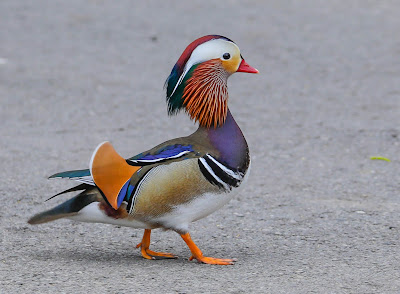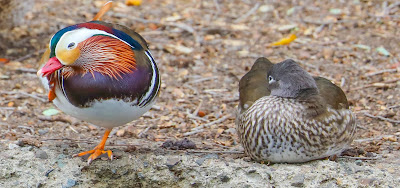The mandarin duck is a duck of East Asia. Wikipedia estimates that there are 1,000 breeding pairs in each of eastern Russia and eastern China and about 5,000 breeding pairs in Japan. Over the years feral populations have been established in Great Britain (about 7,000), Ireland and in the United States, usually from captive ducks escaping and then reproducing in the wild. It prefers the forested edges of rivers and lakes and fresh water.
It has been described as the most beautiful duck in the world. The male has: (a) a red bill with a white tip; (b) a crest that begins at the beak and flows back off the neck, with sections of green blue and red; (c) white on the upper half of the face and shaded orange on the lower half of the face; (d) a black eye; (e) huge puffy reddish/orange "whiskers" that protrude down over the neck; (f) a purple breast with two vertical white bars; (g) a white belly; (h) orange legs and feet; (i) two orange feather "sails" that poke up off the back behind the feet; (j) a black back with sections of dark blue, black and white; and (k) sides that are orangish/brown.
The female has: (a) a grayish head; (b) with a black eye; (c) surrounded by a white ring with a trailing white stripe; (d) a grayish bill with a hint of red; (e) dark brown feathers on the back; (f) brown and white specked breast and sides; (g) a white belly; (h) yellowish legs and feet; and (i) wing feathers that include green, blue and black and white stripes.
I was at Irvine Regional Park last Saturday looking for wood ducks and spotted a male and female mandarin duck intermixing with them and other mallards and American wigeons. I've seen a newspaper article and photos of mandarin ducks at Irvine Regional from prior years and assume it is probably these same two ducks having taken residence. They can fly and certainly can leave if they want to.
















Such incredible photos of such gorgeous birds. It would be interesting to know more about their evolutionary history. Why so fancy??
ReplyDelete